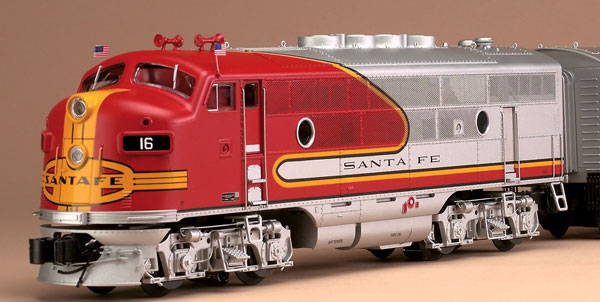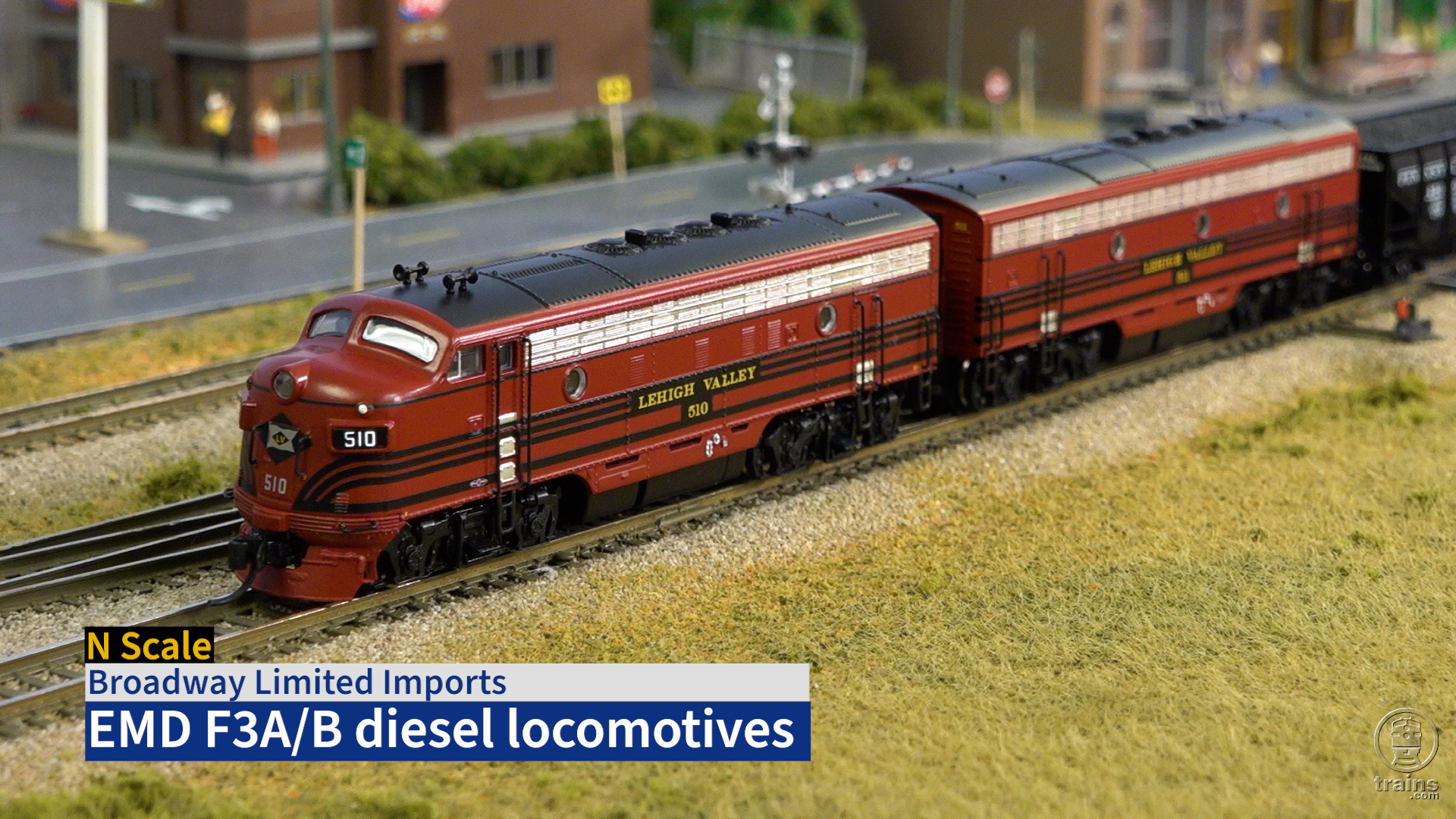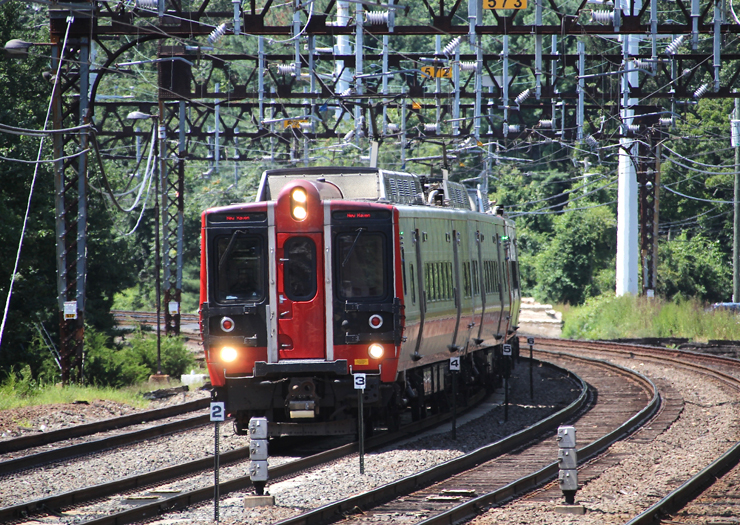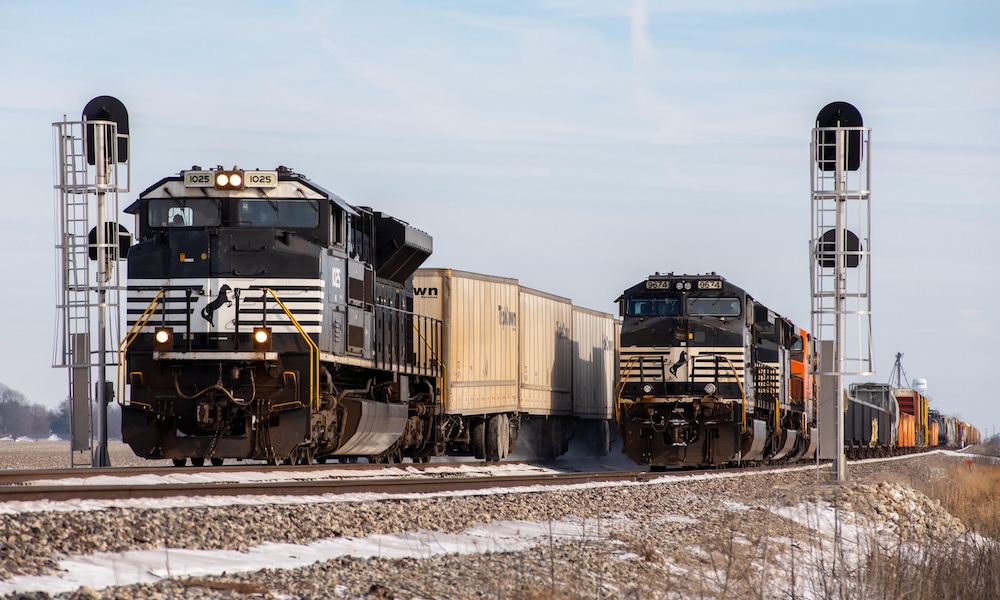But this new Lionel F3 is not your father’s F3. What we have here is a Lionel F3 that’s actually all new. Not tweaked. Not modified. But brand spanking new from the bottom of the trucks to the top of the horns.
Honoring its heritage, the new F3 is available in the same road names as Lionel’s 1948 originals: New York Central and Santa Fe.
The model
Frankly, in spite of the pre-production hype and a sneak preview at last fall’s big TCA divisional meet in York, Pa., I wasn’t expecting this new diesel, sold as an A-A outfit with a separate-sale B unit, to look that much different from the old F3. But right out of the box the warning bell was ringing – “there’s something special about this locomotive.”
I sat it on a counter, right next to my postwar no. 2344 New York Central F3 A-A combination, and sure enough, the new scale-size unit is taller than the vintage model and its windshield openings are taller. And the details of the new F3! I quickly turned my eyes because the new F3 made my beloved postwar model look – well – shabby and toy-like.
Turning to my tattered January 1970 issue of the locomotive news magazine Extra 2200 South, I got the lowdown on the various phases of F3 production.
Not all F3s produced by General Motor’s Electro-Motive Division between 1945 and 1949 were identical. One of the characteristics of Phase II production is the so-called “chicken wire” screens running down each side of the body at the roofline and between the fore and aft portholes. On Lionel’s Phase II model you can see right through the screens to the simulated structural supports. You can even see the openings four vents placed between portholes. The vents became louvers in July 1948 during Phase III production.
The gentle, curving bulldog nose on the new Lionel model looks great. The carefully crafted painting and decoration are second to none. I took a magnifying lens and went over the body and found no flaws in the warbonnet paint scheme.
For attention to detail and execution of decoration I give this baby two thumbs up. For example, the Santa Fe version accurately has a headlight and a Mars light, while the New York Central version possesses only a headlight. The Santa Fe unit features large number boards rather than the smaller ones inherited by some F3s from the FT assembly line.
The pilot has an exceptional number of doodads, such as built-in steps, air hoses, and a simulated uncoupler arm. It puts the file-marked pilots on postwar F3s to shame.
The cab doors open, and the silver kickplates and add-on steps are a nice touch. The cab has two crew figures and a simulated interior. One of the spiffiest things about the cab interior is the way Lionel handled the plastic shield that hides the can motor. It is simply painted red, and sure enough, it blends into the background nicely.
There are two light bulbs in the cab, but I’m not sure this is a good idea. When the train is rolling along, the cab emits a blazing amount of light and tends to be distracting. Your eyes are drawn to the light, not the crew figures or the cab windows. A single lower voltage bulb, as in the cabs of some O gauge steamers, would be better.
Above the cab windows you’ll find two American flags. These came installed right out of the box. I gave the flags a tug to try to remove them before I flipped the locomotive on its back to remove its shell. The flag staffs didn’t budge, and although they are made of flexible plastic, you’ll want to take care not to damage them.
Owners of the original Lionel F3 with its flat roof fans may gasp at the much taller roof-fan housings. Visually they aren’t my cup of tea, but they are accurate and nicely modeled.
In addition to the cab doors, the doors along the sides and ends of the shells also open, and the rear door features a horizontal safety bar (to keep O scale crew members from falling!).
On the test track
The powered F3 features two can-style motors atop each truck, with circuit boards including TrainMaster Command Control, RailSounds, and Odyssey speed-control in the center of the frame.
Operation generally was smooth, but recorded speeds varied considerably between conventional-control mode and command-control mode. Running in conventional-control mode, the F3 clocked a speedy low-end average of 36.6 scale mph. However, in command-control mode, the low-end average dropped to a far more pleasing 6.6 scale mph. High-end speed average was 133.9 scale mph. Drawbar pull for the 4- pound, 91/2-ounce A unit was 2 pounds, 1 ounce. Pulling our 25-car multiple-make and vintage test train at 18 volts in conventional-control mode, this baby cruised along at 92.5 scale mph.
As with recent Lionel multiple-unit diesels we have tested such as the Southern E6 (March, 2003), there are no tethers between the F3 units. The dummy A unit has its own TMCC receiver, and it is programmed from the factory as engine no. 2. To operate both A units in sync, you must address them as a lashup. Lionel selected lashup no. 9 for the A-A pair, but as with all TMCC addresses, you can change it.
I was a bit surprised that only one A unit was powered and each of the outfit’s trucks have just one pickup roller instead of the usual two. The rollers are 6 inches inches apart, enough to span the variety of switches on all of the home layouts we used to test the F3.
Both A units feature coil couplers on the pilots, and each A unit is smoke equipped. The B unit doesn’t do anything, but it is as pretty as can be! It too has opening doors, and, while it has no smoke unit, it does have a backup light and its rear coupler is a coil coupler.
Conventional operation was generally good. Command-mode running was more problematic.
On our workshop test loop things operated to a satisfactory level, but on two home layouts we encountered some irregularities using TMCC. There was some hesitation in movement that we weren’t expecting. There was also a bit of light flickering (when standing still), suggesting a problem receiving TMCC’s radio signals.
We encountered signal-strength problems on two different TMCC-equipped layouts. The problem on one layout was bad enough that the F3 couldn’t pull a train around a full lap without stalling.
We’ve run dozens of TMCC-equipped locomotives with no trouble on these layouts, so the problem lies with the antenna inside our particular sample F3 A unit. We checked inside, but all looked shipshape.
The full A-A plus B diesel set isn’t cheap, but at $899.95 it is still less than the $1,005.90 needed to buy 1996’s top-of-the-line Santa Fe A-B-A package. (If I had only known then …) Lionel’s F3 is the new sheriff in town, and once you open its box, you’ll find your old F3s running for cover.















I recently received a #2343 A-B-A Santa Fe freight set, circa 1950, as a gift from a friend; so I found this review of a modern issue very interesting. I still can't believe my good fortune…it's the fullfillment of a childhood dream!